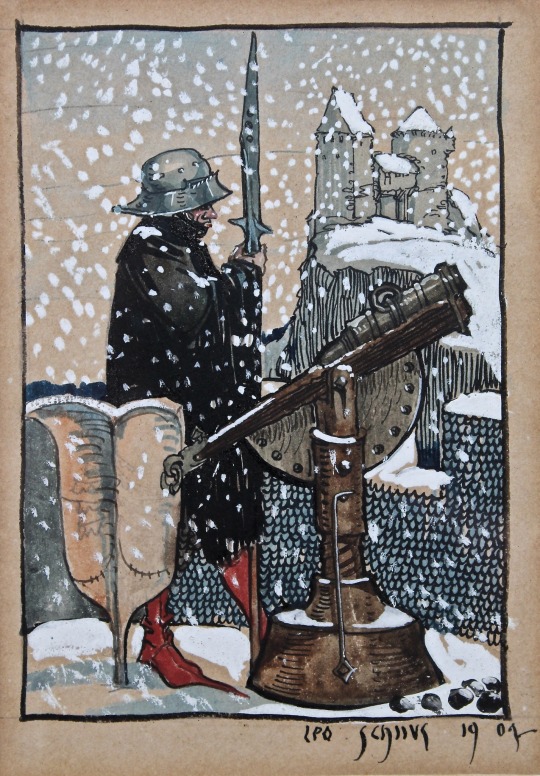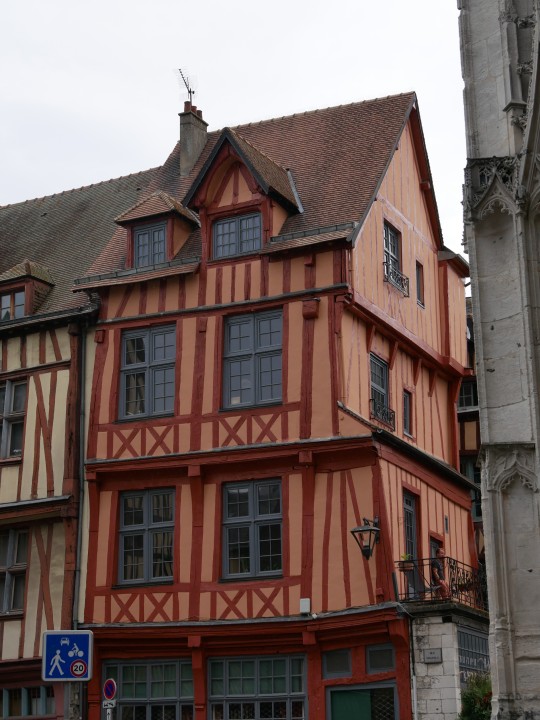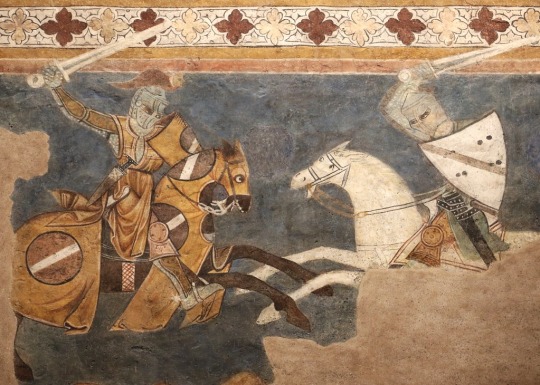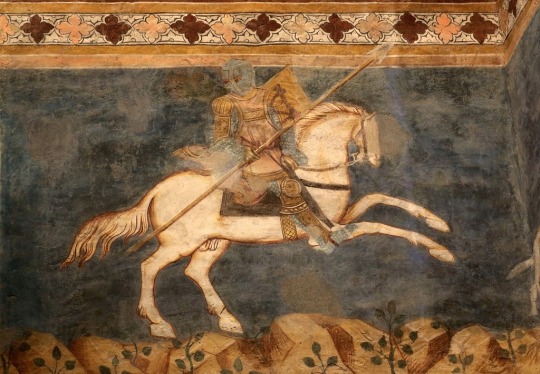15th century reenactor - Illustrator - passion for all things late medieval!
Don't wanna be here? Send us removal request.
Text
Today's #FloraFriday is this lovely flower which seems to be painted in the center of an astronomical diagram. It appears on f. 55v of LJS 216, a collection of three astronomical and cosmological treatises written in France between 1256 and 1270
Online: https://bit.ly/3H5br5r
59 notes
·
View notes
Text

In 1400s a dog dueled who he suspected to be the murderer of his owner
38K notes
·
View notes
Text

A mermaid
Add MS 62925 f.96r
Source: The British Library
10 notes
·
View notes
Text
Female Knights in Medieval History
While women have been fighting alongside men for all of history, they usually don't get the same recognition as their counterparts. Here are some cases where women did get accepted into chivalric orders, though they typically got a separate title. Some of the women were combatants, and some were not (but non-combatant men have been accepted in chivalric orders for just as long!)
Order of the Hatchet (12th century Spain) Orde de l'Atxa|Orden del Hacha was an entirely-female order created after women defended the Catalonian town of Tortosa from invaders. With most adult men off to war, the women fought with hatchets and other tools. Women of this order were given social and financial privileges, including tax exemptions.
Order of Saint-John (12th century Malta) A military religious order, the Order of Saint-John had female soeurs hospitalières and male frères prêtres who had essentially the same role in the order.
Teutonic Order (12th century Jerusalem) The Order of Brothers of the German House of Saint Mary in Jerusalem accepted women primarily as consorores and hospitallers, in charge of supportive and medical services. However, these women did follow men to war to perform battlefield medicine.
Knights Templar (12th-14th century Jerusalem) The members of the Poor Fellow-Soldiers of Christ and of the Temple of Solomon admitted women for a number of roles. We know that when the final got around to writing down their rules, it included continuing the already standard practice of admitting women. Most Knights Templar were noncombatant, especially financiers.
Order of the Garter (14th-15th century England) Dedicated to the patron saint of England, Saint George, the Most Noble Order of the Garter admitted women regularly, often due to blue blood. However, women without high birth were admitted as well.
Order of the Ermine (14th and 15th century France) The L'Ordre de l'Hermine was directly inspired by the Order of the Garter and dedicated to upholding one's personal honor. It openly admitted men and women of any social rank, including the only known instance in Medieval history of a woman serving as Officer of Arms. This woman, Katherine Potier, was titled "Espy Herault".
Order of the Blessed Virgin Mary (13th-16th century Italy) A unique order that took up arms to pacify cities in the fractured Italian states. It was centered in Bologna and would admit women as fighters called militissa (literally 'female knight').
4K notes
·
View notes
Text

"Ordinary people are often hard to see in the historical record. This resource for students reveals the everyday world of the Middle Ages for women: sex, marriage, work, and power. Using up-to-date scholarship from both archeology and history, this book covers major daily concerns for medieval people, their understanding of the world, their relationships with others, and their place in society. It attempts to clarify what we know and what we do not know about women’s daily lives in the Western European Middle Ages, between approximately 500 and 1500 CE."
8 notes
·
View notes
Text

Fiddler with a tall hat
Add MS 10294/1 f.ar
Source: The British Library
78 notes
·
View notes
Photo


Rare self-portrait of a medieval artist
While a lot of medieval manuscripts with colourful drawings survive, we are usually not shown the artists who decorated the pages. This image is therefore exceptional, because it does. In fact, we see him drawing the decorated letter that contains, well, himself! This is, in other words, a rare medieval self-portrait. The artist shows himself surrounded by paraphernalia of the trade, such as brushes and pots of paint. He even puts his name next to himself, which is atypical for the usually modest monks of the age: “Frater Rufillus”, who was a monk in Weissenau abbey in Ravensburg, Germany, near the end of the 12th century. We catch Rufillus putting the finishing touches on the letter R: the last stroke by a proud monk, who couldn’t help but showing himself to the world.
Pic: Cologny, Collection Martin Bodmer, MS 127 (12th century). More information about (and the full facsimile of) this manuscript here.
997 notes
·
View notes
Text
Every time I see a picture of super shiny, polished armor I want to kick a Victorian.
31K notes
·
View notes
Text
“No matter which way I looked at it and no matter how much I turned the matter over in my mind, I could find no evidence from my own experience to bear out such a negative view of female nature and habits. Even so, given that I could scarcely find a moral work by any author which didn't devote some chapter or paragraph to attacking the female sex, I had to accept their unfavourable opinion of women since it was unlikely that so many learned men, who seemed to be endowed with such great intelligence and insight into all things, could possible have lied on so many different occasions”
CHRISTINE DE PISAN, The Book of the City of Ladies
#late medieval#medieval history#history#middle ages#15th century#14th century#feminism#the middle ages#1400s#1450s#medieval queens#book quote
50 notes
·
View notes
Photo
The tale of St. George and the dragon became very popular in the fifteenth century. But something sinister was appearing in the story. Dr Riches looked at late fifteenth- and early sixteenth-century pictures depicting the tale and realized that in many of them dragons had female genitalia. This portrayal of the dragon as female and sexual is probably connected to fears about women's sexuality during this time. The "damsel' in the pictures is 'saved by St George, who symbolizes chastity, from the dragon who symbolizes her own uncontrolled sexuality, Women's sexuality was being associated with a monster, suggesting that this sexuality was seen as evil and threatening. St George was the patron saint of towns, and in towns that were actively legislating against women traders this view seems entirely possible. What began in towns ended by dominating the country. When religious dissent developed it was the craftsmen and tradesmen of the towns who led it, and urban Protestantism would eventually take over England.
- Medieval Lives, Terry Jones, BBC Books p. 188

Friedrich Herlin St. George as dragon slayer
Mixed technique on wood, 44.5 x 29.2 cm, ca. 1460-61
#st. george#dragon#15th century#1450s#1400s#late medieval#medieval art#the middle ages#medieval#history#medieval history
491 notes
·
View notes
Photo
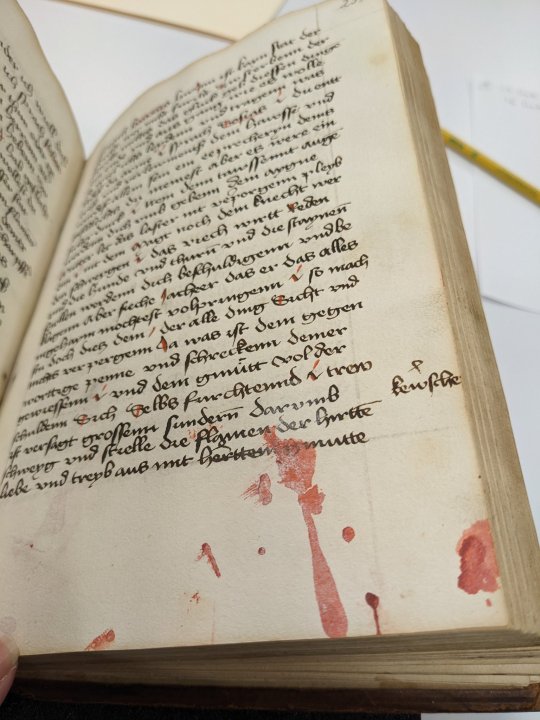
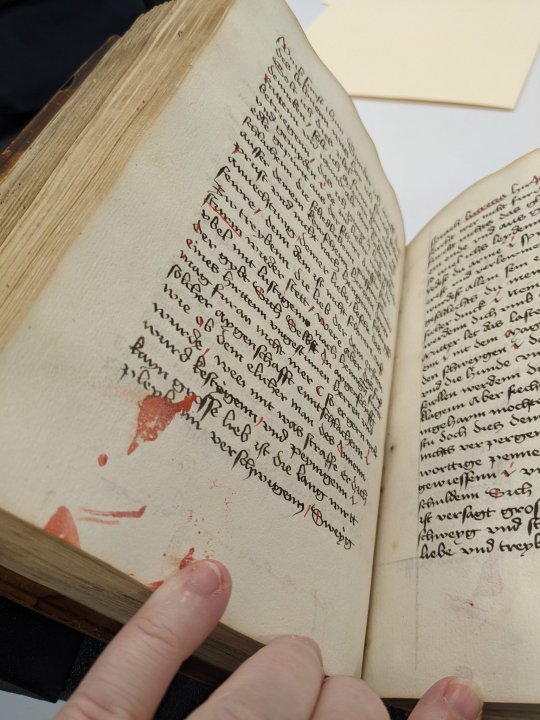

Oopsie! I’m 98% certain a cat was involved, somehow.
(UPenn Ms. Codex 1077)
247 notes
·
View notes
Photo

Illuminated initial ‘A’, cut from a copy of Suidas’ 'Lexicon Graecum’ (Milan, 1499).
Gold leaf, bodycolour and watercolour.
© The Trustees of the British Museum.
Creative Commons Attribution-NonCommercial-ShareAlike 4.0 International (CC BY-NC-SA 4.0) license.
175 notes
·
View notes
Text



Polyptich of the Last Judgement by Rogier van der Weyden, 1452
45 notes
·
View notes

